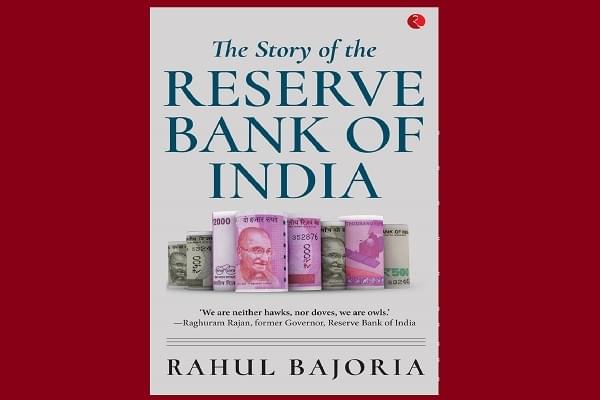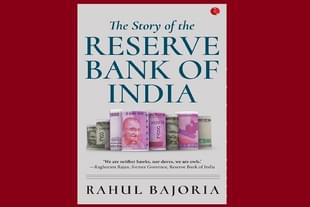Books
A Biography Of India’s Banking Sector
Aashish Chandorkar
Nov 18, 2018, 02:08 PM | Updated 02:08 PM IST
Save & read from anywhere!
Bookmark stories for easy access on any device or the Swarajya app.


A book on the Reserve Bank of India (RBI) written by a career economist will by default be assumed as a technical effort, full of arcane jargon. But Rahul Bajoria’s maiden book “The Story of the Reserve Bank of India”, is anything but that.
This book is positioned as a chronicle of how the RBI has evolved in India. It is a story of India’s central bank, how it was set up, how its functions were decided, and how it evolved in its journey to where it stands today. The book is a chronicle, which explores various aspects of the functioning of the central bank, but steers clear of detailing complex operational responsibilities.
The book, in fact, starts in 1773 and covers ground on how banking evolved in India. Bajoria, an economist based in Singapore, covers the stellar role played by Osborne Smith, James Taylor, and CD Deshmukh in evolving the bank. He covers little-known tidbits around how the RBI worked for some time as Pakistan’s central bank and builds up the imminent ‘Indianisation’ of the RBI in the 1950s.
The author details out the event of the 1960s, when Indian banking became nationalised and the policy thrust changed to a sharp left orientation. In covering the story of that decade, he subtly brings out the distinction between being independent in the realm of the government as against bowing down to the government across a range of decisions. Some of these nuances can be applied to today’s government - RBI conflicts as well. The story of how the RBI had to support nationalisation, at the same time avoid being a ‘reportee’ to the Department of Banking is especially stressed.
The section on how the bank survived the 1970s is equally fascinating. This was the decade when the gold standard crumbled, the world witnessed the first oil shock, and India saw an Emergency. India even went through a demonetisation towards the end of the decade. This was the era when the monetary policy function of the RBI became more critical. The political overtones of what the RBI did were the sharpest during this decade. The author again weaves a lucid narrative of how the RBI held up to a series of global and local stimuli, mostly negative and challenging.
The story then moves on to establish the importance of the banking sector regulation function of the RBI through the lens of the events of the 1980s and 1990s. As India opened up its economy while facing a debilitating balance of payments crisis, RBI had to strengthen its regulatory arms and instincts. Bajoria details out how the private players entered the market and RBI had to learn a lot of new things by actually doing them through this period.
In the last two decades, the Indian economy has become closely tied to the global economic system more than ever before. In terms of its policies, as well as behaviour and conduct, the RBI has had to look more like its global peers than ever before. The book covers this aspect in great detail - how RBI emerged and evolved as a central bank clued into the international monetary and financial system.
Another aspect which the book addresses in great detail without getting too individual-centric is the role of the various Governors of the RBI. The work of everyone - from CD Deshmukh to Raghuram Rajan - is chronicled, and the book is actually a great resource to understand what challenges each Governor faced and what his response was. The author does not personalise these stories, but merely recounts the work done by each individual. In some ways, the book actually takes the glamour out of the RBI Governor role by establishing that every individual has had its own challenges. The current age media spotlight makes various situations sound more unique. In reality, a lot of what we see with respect to the RBI had transpired in the past already.
The author gives more space to the events of this millennium when the RBI has had to respond to global upheavals. The RBI response to the sky-high inflation of the early part of this decade, the farm loan waivers of 2008, and the big foreign capital inflow of 2004-2007 is well documented and explained. The author also details how each of these seminal events changed the way in which the RBI analysed and acted upon economic data.
Finally, the book analyses the tenure of Raghuram Rajan - his ideas, advice, and the interactions with the government. The author stresses that several conflicts were overanalysed and probably overblown. The book ends with a short commentary on demonetisation, its intent, execution, and various outcomes.
This is a history book - the subject is economic. It is an anthology of economic events which have shaped international and hence Indian banking over several decades, and the corresponding response of the system through the RBI. This is not a value judgment on the RBI - Government of India relationship; the topic is only covered in terms of how the two sides have interacted through various critical situations. And as the book ends its journey in late 2017, the present day conflicts are not a part of the story.
The writing is very easy going. The use of layman language and the sectional divide makes reading non-strenuous. Wherever there are specific economic terms, the author attempts to simplify them. Unlike various other books on the RBI history which relied heavily on the RBI archives and complex recommendations of various committees which drove the RBI evolution, this book is a simple, straightforward, to the point, and non-judgmental history book.
I have known Rahul for a little over six years now and have read a lot of his professional works as well as commentaries. He excels and exceeds himself effortlessly in this masterful debut. The Story of the Reserve Bank of India is a high quality, supremely professional effort, executed with a lot of passion as an individual but completely dispassionately as an author.
Aashish Chandorkar is Counsellor at the Permanent Mission of India to the World Trade Organization in Geneva. He took up this role in September 2021. He writes on public policy in his personal capacity.





